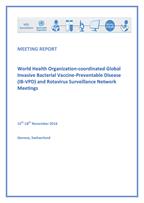Invasive Bacterial Vaccine Preventable Diseases Laboratory Network
The Global Invasive Bacterial Vaccine-Preventable Diseases (IB-VPD) Laboratory Network is an important component of the WHO-coordinated Global IB-VPD Surveillance Network. It contributes to the surveillance objectives of documenting presence of disease, identifying circulating serotypes, and measuring serotype distribution. In the post-vaccine introduction period, the laboratory network generates data to assess disease trends over time and monitor changes in circulating strains/serotypes in different countries and regions.
As of December 2017, the network includes 88 Sentinel Hospital Laboratories (SHL), 26 National Laboratories (NL), nine Regional Reference Laboratories (RRL), and one Global Reference Laboratory (GRL). The initial laboratory testing for diagnosis is conducted at the SHL and additional testing such as strain characterization (serotyping/serogrouping) is done at the NL or RRL.

Substantial progress has been made in establishing and sustaining the first global IB-VPD laboratory network, developing standardized laboratory procedures and guidelines for data collection, and implementing quality assurance/quality control systems. A global external quality assessment program (EQA) monitored by WHO in coordination with Public Health England documents national, regional, and global laboratory capacities in IB-VPD pathogen diagnosis and molecular typing. In 2016, 94% of the participating IB-VPD laboratories passed the EQA, including the regional reference laboratories (RRLs), national laboratories (NLs) and sentinel site laboratories (SSLs). All laboratories were evaluated on pathogen identification by testing on viable cultures. For NLs and RRLs with PCR capacities, laboratories were also tested on their ability in serotyping/serogrouping the bacterial pathogens using simulated clinical samples of cerebrospinal fluid (CSF). Efforts are underway to optimize critical laboratory procedures used at the global and regional reference laboratories to facilitate inter-laboratory data comparability and improve serotype/serogroup data quality and linkage to epidemiological data.
As part of global efforts to improve surveillance of IB-VPD, regional laboratory workshops were conducted in 2017. These workshops aimed to increase capacities for and expand use of direct real-time polymerase chain reaction (PCR) for detection and characterization of bacterial meningitis agents.





